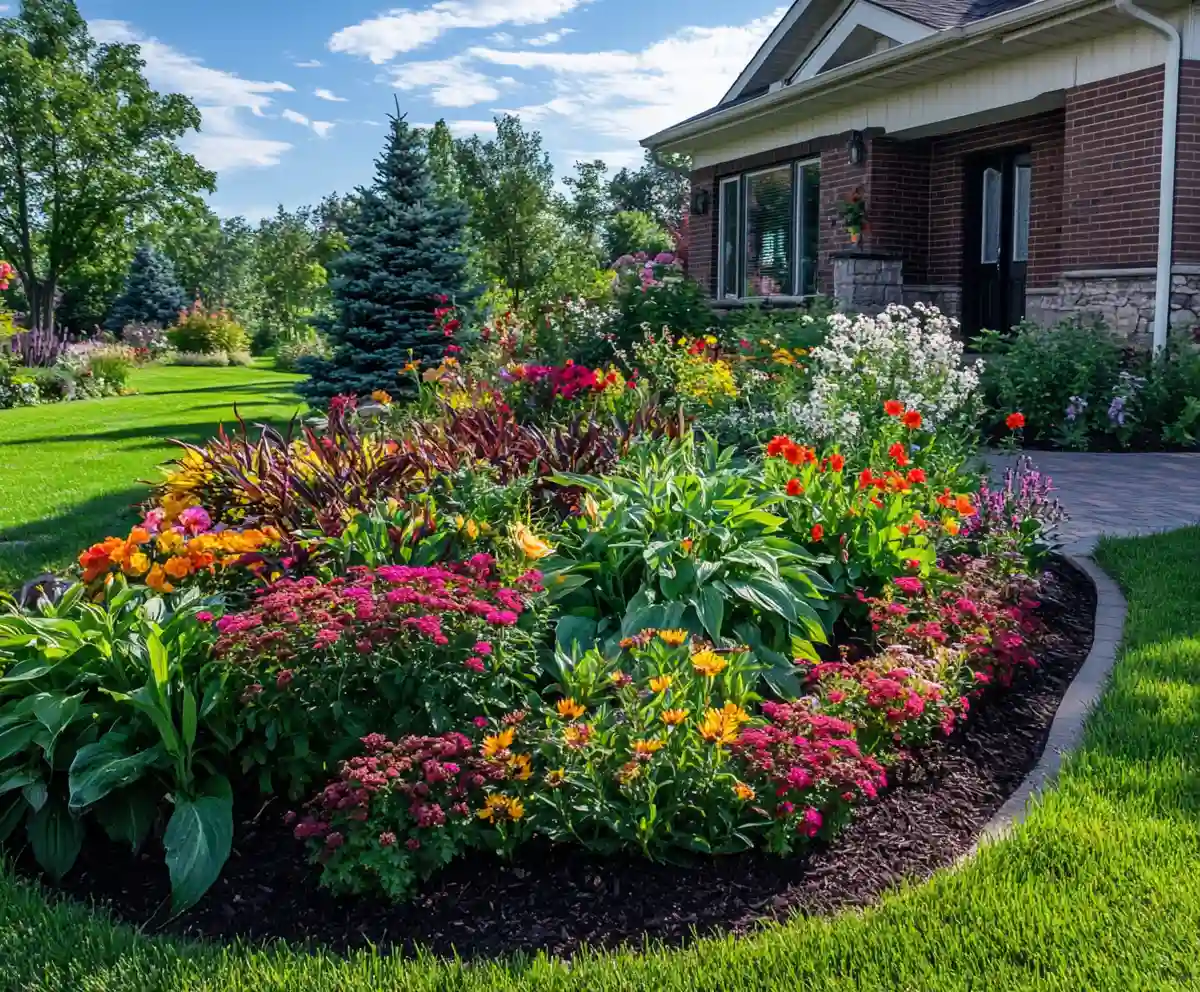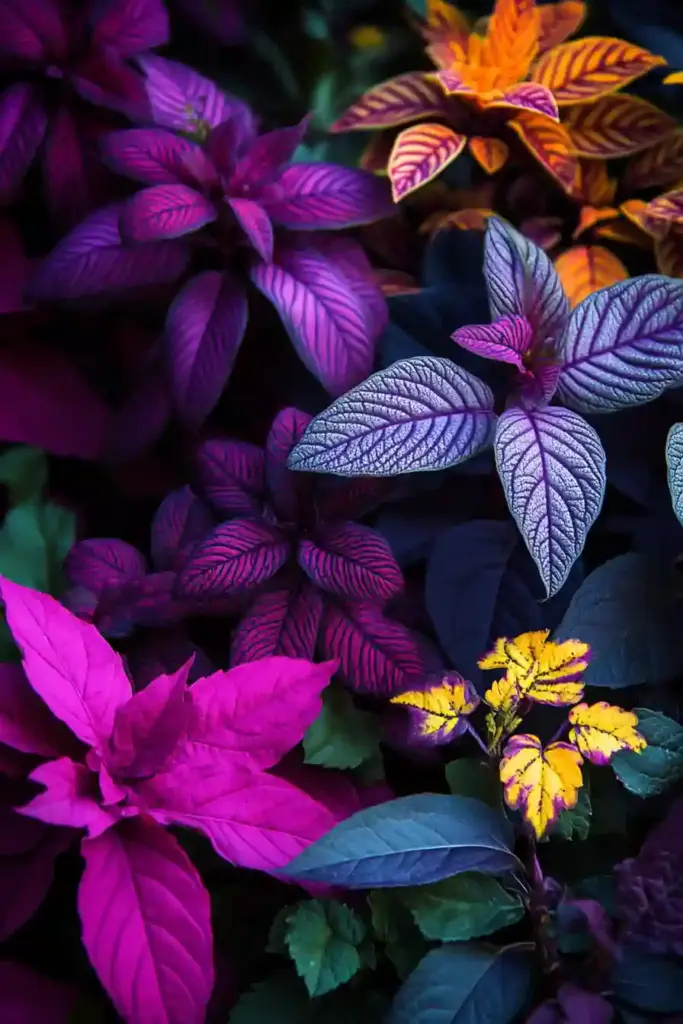Do you dream of a garden that keeps turning heads month after month—not just during a quick summer bloom? Whether you’re a newbie or a seasoned green thumb, learning how to design an eye-catching, ever-blooming perennial garden doesn’t have to be complicated.
In fact, perennials made easy is more than just a dream—it’s totally doable with the right approach. These low-maintenance plants return year after year, saving you both time and money. But here’s the secret: it’s not just about grabbing the prettiest blooms at the garden center. To keep your garden bursting with color from spring through winter, you need a little strategy—and that’s exactly what we’re diving into here.
Get ready to discover how to build a thriving, four-season perennial garden that’s anything but boring!
The #1 Mistake New Gardeners Make With Perennials 🌼
It’s tempting—you’re walking through a garden center, and those vibrant blooms practically beg to come home with you. Most gardeners fall into the same trap: choosing perennials based solely on how they look in bloom. It’s what I like to call “flower fixation.”
While flowers are undeniably the stars of the show, relying only on what’s blooming right now leads to one major problem: a garden that looks amazing for a few weeks, then turns into a sea of green for the rest of the year.
Why does this happen? Most perennials bloom for just a short time—maybe a few weeks per season. If all your plants flower around the same time, the rest of your garden calendar stays… well, pretty dull.
Break the Flower Fixation Cycle
Instead of buying whatever’s blooming on the shelf, think ahead:
- When will this plant bloom in my garden?
- What does its foliage look like when it’s not flowering?
- Will it pair well with other textures and colors?
Most plant tags will tell you bloom times—use this info! Creating a truly dynamic perennial garden starts with knowing that color doesn’t have to come from flowers alone. In fact, the best gardens are layered with interest in every season.
Designing Perennial Beds That Pop – Even Without Flowers 🎨
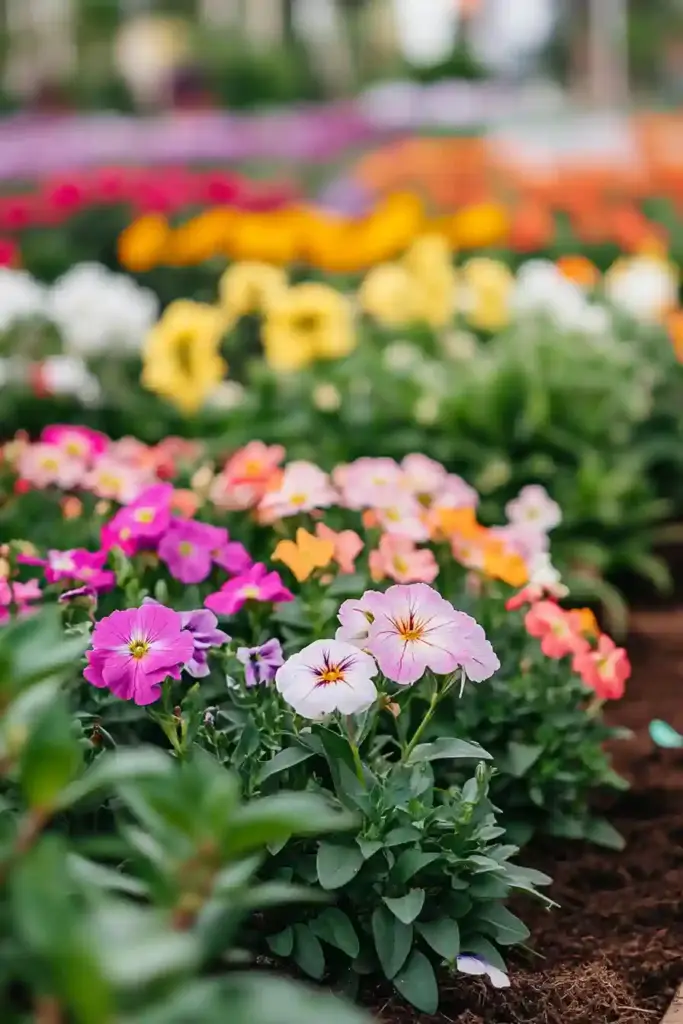
Want a garden that looks gorgeous even when nothing’s blooming? The secret lies in focusing on foliage first.
While it might feel counterintuitive, building a perennial bed around leaf shape, texture, and color creates a strong visual foundation. That way, when the blooms do show up, they’re just the cherry on top.
🌿 Why Foliage is Your Garden’s MVP
Think of leaves as the backdrop for your flowers—like the stage for a play. Without that strong base, even the brightest flowers can look lost or underwhelming.
Here’s how to use foliage to elevate your garden’s design:
- Mix Leaf Colors: Go beyond green. Look for plants with burgundy, silver, lime, chartreuse, variegated, or deep purple leaves.
- Layer Textures: Combine big, bold leaves (like hostas) with fine, airy foliage (like ferns or ornamental grasses).
- Vary Shapes & Heights: Contrast round leaves with spiky ones. Plant low-mounding perennials alongside tall upright varieties.
Even if not a single flower is blooming, your garden will still offer a beautiful, textured tapestry that draws the eye.
Quick Tip:
If your perennial bed feels “flat” or all one shade of green, it’s time to add some color-rich foliage. It’s one of the fastest ways to upgrade your garden—no blooms required!
Secrets to an Ever-Blooming Garden 🌼
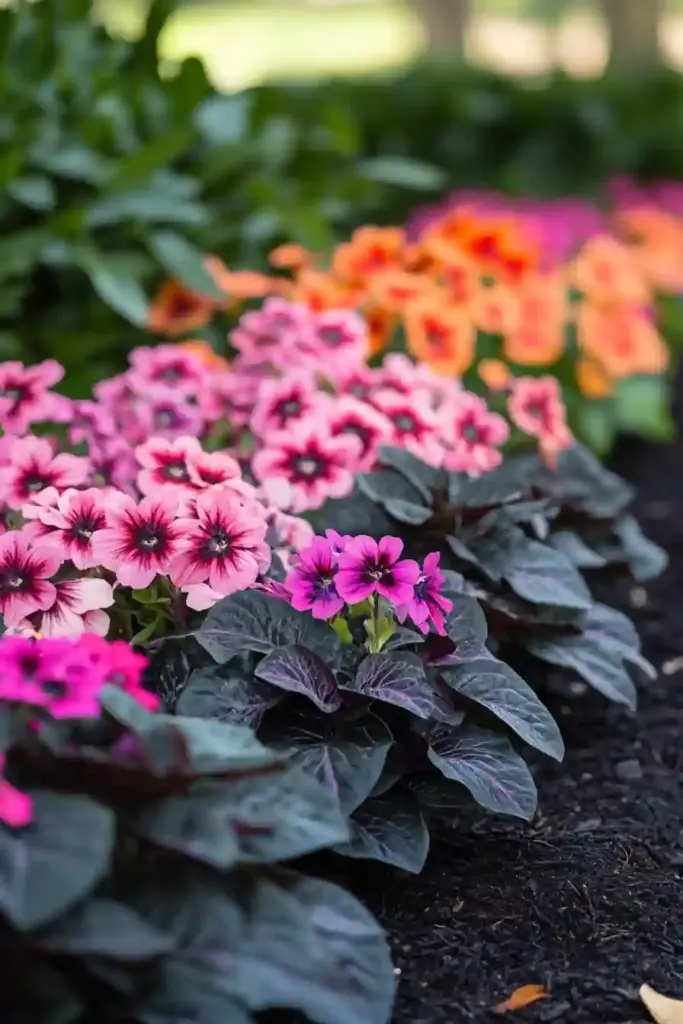
If your goal is to have a perennial garden that puts on a show from early spring to the first frost (and even beyond), it’s all about planning your blooms like a symphony—each plant taking its turn in the spotlight.
Below are the two golden rules for achieving that dreamy, ever-blooming effect:
🌸 1. Mix Bloom Times Strategically
The key to continuous color is staggering your bloom times. Here’s how:
- Choose plants that bloom in early spring, late spring, summer, and fall.
- Don’t cluster all spring bloomers in one spot—blend different bloom times together so something is always popping.
- Read plant tags or descriptions to know when each perennial will flower. Don’t rely on what’s blooming in-store.
💡 Pro Tip: Try not to place more than two or three plants that bloom at the same time right next to each other. Instead, aim for overlapping waves of color across your bed.
🌿 2. Prioritize Foliage Variety
Yes, we’re back to foliage—but for good reason! While staggered blooming keeps flowers cycling, diverse foliage ensures your garden never feels empty.
Think beyond flowers by including:
- Year-round interest plants like coral bells, sedum, or ornamental grasses.
- Color-rich leaves that keep things lively even after flowering fades.
By combining thoughtful bloom planning with dynamic foliage, your garden becomes a rotating display of color and texture that lasts the entire growing season—and beyond.
Planning for All Four Seasons 🗓️
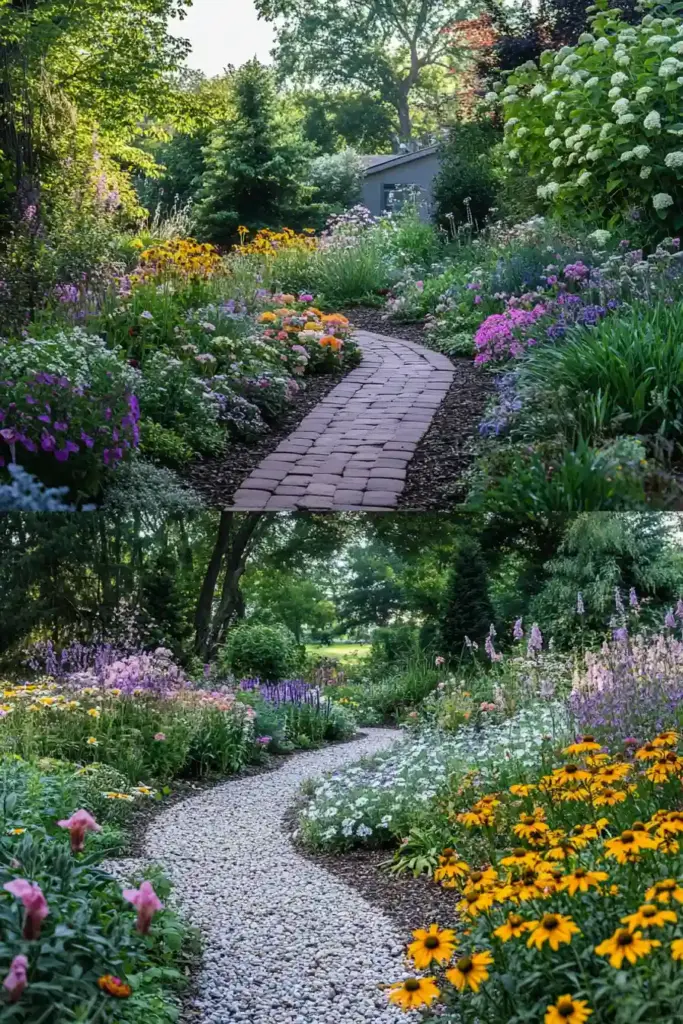
Most gardens shine for a few short months—usually in summer—and then fade into a green (or brown) blur. But with just a bit of foresight, your perennial beds can offer visual interest through spring, summer, fall, and even winter.
Here’s how to keep your landscape looking lively year-round:
🌷 Spring: A Fresh Start
Spring is when your garden wakes up—and it sets the tone for the whole year. Plant early bloomers and bulbs that bring those first joyful pops of color:
- Tulips, crocus, and daffodils are classic early risers.
- Try bleeding heart or creeping phlox for soft textures and shades.
- Add sedum or ajuga with colorful foliage to fill gaps even before flowers appear.
☀️ Summer: The Main Attraction
This is prime time for perennials, but it’s easy to fall back into “flower fixation.” Avoid overload by layering your garden intentionally.
- Mix tall blooms like coneflowers, lilies, and black-eyed Susans with low growers like phlox and sage.
- Don’t forget the foliage backbone—hostas, coral bells, and ornamental grasses add drama and structure.
🍂 Fall: The Bold Finale
Don’t let your garden fizzle in fall—embrace it as the grand finale of the growing season.
- Add late bloomers like sedum, Japanese anemone, hardy aster, and Russian sage.
- Trim back early bloomers to spotlight fall stunners.
- Choose foliage that turns red, orange, or gold as temps cool.
❄️ Winter: Quiet Beauty & Structure
Winter doesn’t have to mean dull. Many perennials offer subtle charm, even under snow:
- Leave up dried coneflower, rudbeckia, and hydrangea heads for texture and bird food.
- Grasses and tall stems catch frost beautifully and add sculptural interest.
- Bonus: skipping winter cleanup benefits pollinators and wildlife.
When you design with the full year in mind, your garden becomes a dynamic space that evolves with the seasons—rather than just a summer showpiece.
Season-by-Season Perennial Plant Suggestions 🌿
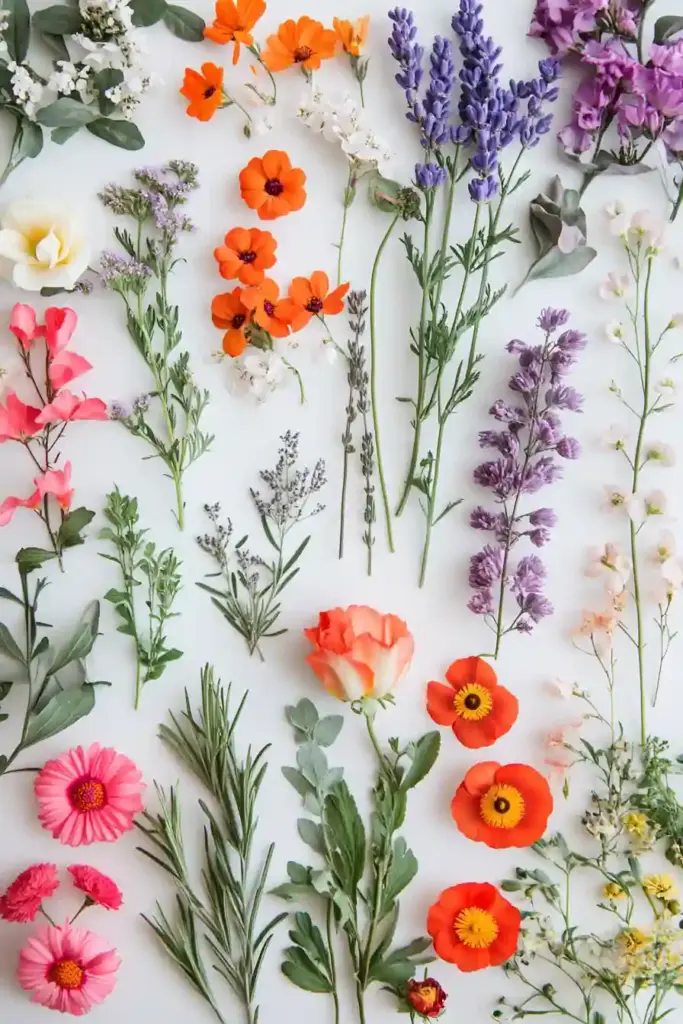
Choosing the right mix of perennials means more than just picking pretty blooms—it’s about building a bloom calendar that keeps your garden exciting from the first thaw to the final frost. Below, you’ll find go-to perennials categorized by the time of year they shine brightest.
🌷 Early Spring Bloomers
These are your garden’s first cheerleaders—popping up even before the lawn turns green:
- Tulips, Crocus, Daffodils – classic bulbs that bring early color
- Bleeding Heart – delicate and romantic
- Creeping Phlox – low-growing and vibrant
- Ajuga – stunning purple spikes and ground cover
- Colorful Sedums – foliage perks up early and stays attractive
🌸 Late Spring & Early Summer
Now things are heating up. These plants bridge the gap between spring and summer:
- Peonies – lush and dramatic
- Irises – elegant with a huge variety of colors
- Hardy Geraniums – low-maintenance bloomers
- Spirea & Weigela – flowering shrubs that mix well with perennials
- Coral Bells (Heuchera) – excellent foliage with subtle blooms
☀️ Summer Stars
This is when your garden should feel full and vibrant—but avoid overdoing it here.
- Coneflowers (Echinacea) – pollinator magnets
- Black-eyed Susan (Rudbeckia) – bold and sunny
- Butterfly Weed – orange bursts that attract butterflies
- Phlox, Liatris, Hardy Hibiscus – long bloomers with color variety
- Salvia/Sage – heat-tolerant and beautiful
🍂 Fall & Late Bloomers
These plants bring garden life back when everything else starts to fade.
- Sedum ‘Autumn Joy’ – foliage + fall blooms = perfection
- Hardy Aster – purple fall punch
- Japanese Anemone – graceful and airy
- Turtlehead, Rue, Russian Sage – strong fall structure and color
- Mums – classic for late-season brightness
❄️ Winter Interest Perennials
While these don’t bloom in winter, they keep your garden looking alive:
- Hydrangea, Astilbe, Coneflower, Rudbeckia – leave dried seed heads standing
- Ornamental Grasses – motion and frost-catching texture
- Sedum – thick stems and foliage hold shape through cold months
🌟 Bonus Tip: Look for perennials with variable bloom times like roses, hydrangeas, and clematis—just be sure to mix early and late varieties so they don’t all bloom at once!
Simple Maintenance Tips to Keep Your Garden Thriving ✨
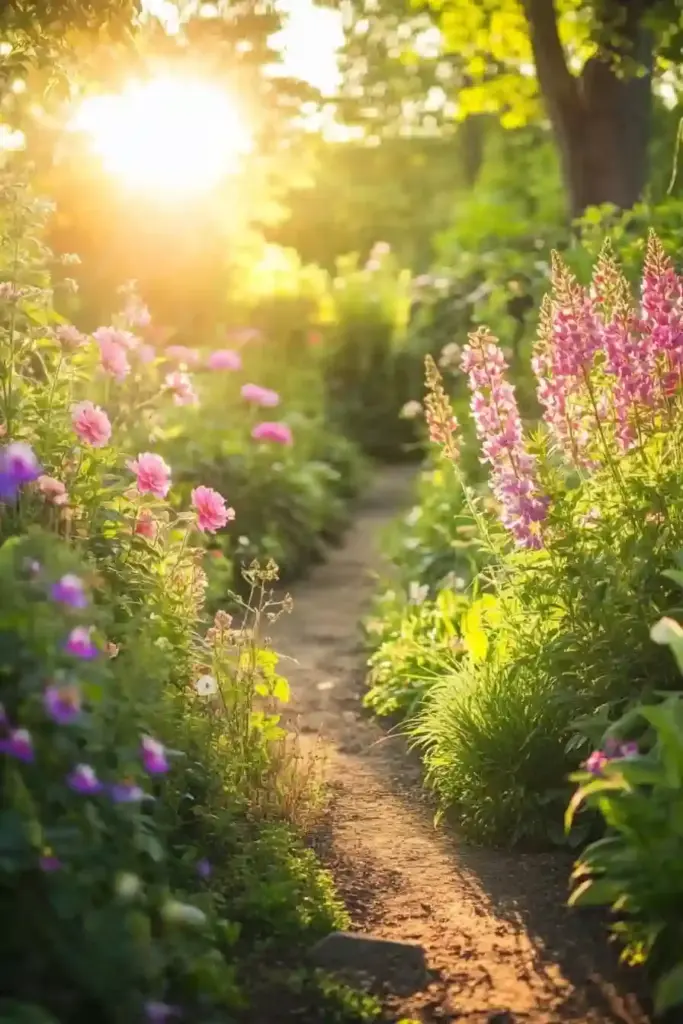
Creating a stunning perennial garden is just the beginning—keeping it healthy and vibrant is where the real magic happens. But don’t worry, maintenance doesn’t have to be overwhelming. A little consistency goes a long way!
Here are the essential tasks that will keep your perennial garden blooming beautifully year after year:
🌱 Mulch to Keep Weeds at Bay
Mulching is one of the easiest and most effective things you can do:
- Helps suppress weeds
- Retains moisture
- Creates a polished, professional look
- Slowly enriches soil as it breaks down
Pro Tip: Use natural hardwood mulch or composted bark for best results. Avoid dyed mulches that can suffocate roots over time.
🍽️ Feed Your Perennials
Even tough, low-maintenance plants need a nutritional boost:
- Fertilize in early spring and again in mid-summer
- Use a balanced organic fertilizer or compost tea
- Don’t overdo it—more is not always better!
✂️ Prune and Deadhead Regularly
Deadheading spent flowers keeps your garden tidy and encourages more blooms:
- Snip off faded blooms weekly during peak season
- Cut back burnt-out foliage to make room for fresh growth
- Give plants a mid-season haircut to keep them bushy and full
Tip: Invest in sharp, ergonomic pruning shears—your hands will thank you!
🪴 Stake Tall or Top-Heavy Plants
Some perennials get a little wild when they’re in full bloom:
- Use discreet plant supports or decorative cages early in the season
- Tie stems loosely with garden twine to avoid snapping
- Staking not only improves appearance—it keeps your plants blooming longer
With just a bit of attention each month, your perennial garden will continue to look lush, tidy, and absolutely full of life.
Final Thoughts & Bonus Garden Wisdom 🌿

Designing a garden filled with perennials doesn’t have to be complicated—it just takes a little thought, some planning, and a willingness to look beyond the blooms.
By mixing foliage textures, staggering bloom times, and choosing plants that thrive across all four seasons, you can create a garden that delivers color, structure, and joy year-round. Plus, with the right maintenance, your perennial beds will flourish with less effort each passing year.
Remember:
- Don’t fall into flower fixation 🌸
- Think in layers: foliage + flowers + seasonal interest 🌱
- Feed, mulch, prune, and support your plants with love 💪
Whether you’re starting from scratch or refreshing an existing space, perennials made easy is more than a motto—it’s your roadmap to a vibrant, low-maintenance, ever-blooming garden.
Now go get your hands dirty, and let your garden evolve into something that brings beauty and happiness season after season. 🌼💚

